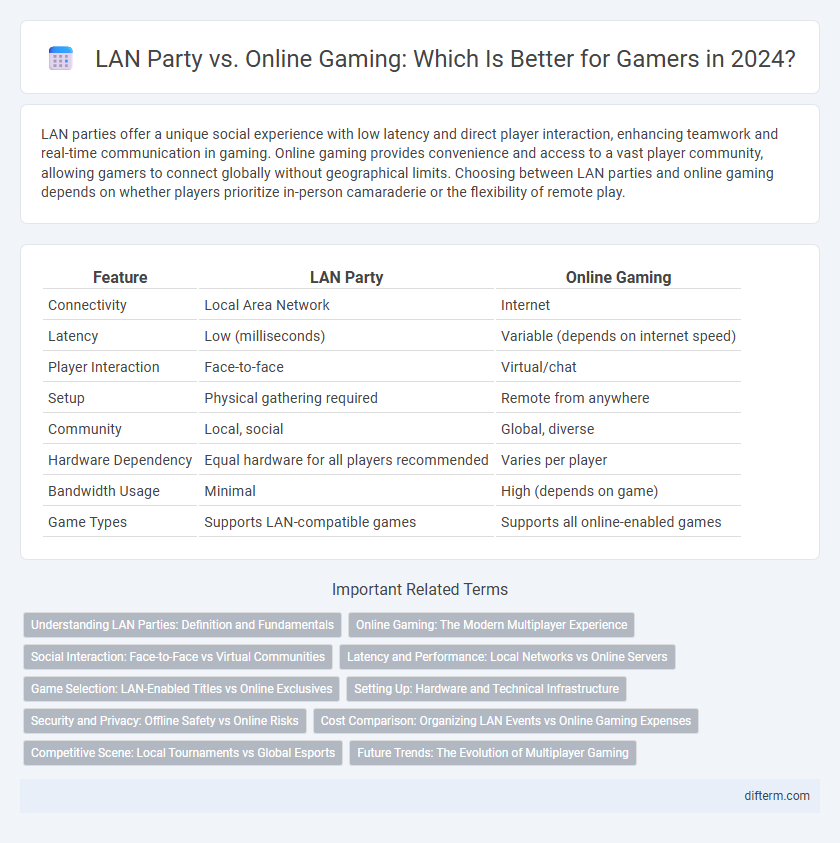LAN parties offer a unique social experience with low latency and direct player interaction, enhancing teamwork and real-time communication in gaming. Online gaming provides convenience and access to a vast player community, allowing gamers to connect globally without geographical limits. Choosing between LAN parties and online gaming depends on whether players prioritize in-person camaraderie or the flexibility of remote play.
Table of Comparison
| Feature | LAN Party | Online Gaming |
|---|---|---|
| Connectivity | Local Area Network | Internet |
| Latency | Low (milliseconds) | Variable (depends on internet speed) |
| Player Interaction | Face-to-face | Virtual/chat |
| Setup | Physical gathering required | Remote from anywhere |
| Community | Local, social | Global, diverse |
| Hardware Dependency | Equal hardware for all players recommended | Varies per player |
| Bandwidth Usage | Minimal | High (depends on game) |
| Game Types | Supports LAN-compatible games | Supports all online-enabled games |
Understanding LAN Parties: Definition and Fundamentals
LAN parties involve gamers physically connecting their computers or consoles within a local area network to play multiplayer games without internet dependency, resulting in low latency and high-speed data transfer. These gatherings foster social interaction, immediate teamwork, and a shared gaming environment, distinguishing them from online gaming that relies on internet infrastructure. Understanding the fundamental setup of LAN parties helps appreciate their unique advantages in enhancing gaming performance and community engagement.
Online Gaming: The Modern Multiplayer Experience
Online gaming revolutionizes multiplayer experiences by connecting millions of players worldwide through high-speed internet, enabling real-time interaction and diverse gameplay across platforms. Unlike traditional LAN parties, online gaming offers persistent game worlds, ranked matches, and extensive social features, enhancing player engagement and community-building. Advanced technologies like cloud gaming and seamless cross-play further expand accessibility and inclusivity for gamers everywhere.
Social Interaction: Face-to-Face vs Virtual Communities
LAN parties provide direct face-to-face social interaction, fostering stronger personal connections and teamwork among players in a shared physical space. Online gaming creates virtual communities where players engage through voice chat and messaging, enabling interaction across diverse geographic locations and time zones. Both platforms offer unique social experiences, with LAN parties emphasizing physical presence and online gaming prioritizing global connectivity.
Latency and Performance: Local Networks vs Online Servers
LAN parties offer superior latency and performance compared to online gaming by utilizing local networks that minimize data transmission delays, resulting in near-instantaneous responsiveness and seamless gameplay. Online gaming relies on distant servers that introduce variable latency due to internet routing and bandwidth fluctuations, which can cause lag and degrade the gaming experience. Local Area Networks provide stable, high-speed connections with minimal packet loss, making them ideal for competitive gaming environments demanding precision and speed.
Game Selection: LAN-Enabled Titles vs Online Exclusives
LAN parties often prioritize LAN-enabled titles like Counter-Strike, Age of Empires, and Halo, which support local multiplayer with minimal latency and direct connections. Online gaming features exclusives such as Fortnite, Apex Legends, and Call of Duty: Warzone, designed for massive player pools and persistent online environments. Choosing between LAN-enabled titles and online exclusives depends on preferences for hardware setup, social interaction, and gameplay style.
Setting Up: Hardware and Technical Infrastructure
Setting up a LAN party demands extensive hardware preparation, including routers, switches, and Ethernet cables to establish a stable local network for low-latency gameplay. Online gaming primarily relies on individual internet connections and servers, minimizing the need for physical networking equipment but requiring robust bandwidth and reliable Wi-Fi or wired internet access. Physical infrastructure at LAN parties often enhances synchronization and reduces lag, whereas online gaming infrastructure depends heavily on server quality and geographic proximity to game servers.
Security and Privacy: Offline Safety vs Online Risks
LAN parties offer enhanced security and privacy by limiting gameplay to a controlled, offline environment, reducing exposure to hacking, data breaches, and malicious attacks common in online gaming. Offline connections prevent the sharing of personal information over the internet, minimizing risks associated with data theft and unauthorized access. However, online gaming requires robust cybersecurity measures such as firewalls, VPNs, and encrypted communication to safeguard player data and maintain privacy against persistent online threats.
Cost Comparison: Organizing LAN Events vs Online Gaming Expenses
Organizing LAN parties typically involves upfront costs such as venue rental, hardware setup, and network infrastructure, which can be substantial but often result in a one-time investment. Online gaming expenses mainly consist of subscription fees, game purchases, and potential in-game microtransactions, leading to ongoing costs that vary with frequency of play. Comparing both, LAN parties may require higher initial capital but lower recurring expenses, whereas online gaming spreads costs over time with more flexible budgeting options.
Competitive Scene: Local Tournaments vs Global Esports
Local LAN parties foster intense competitive scenes by enabling direct player interaction, immediate feedback, and network stability, crucial for high-level play. Global esports tournaments expand competitive reach, allowing diverse player participation and massive audience engagement through online streaming platforms. Both formats drive skill development and community growth, with local events emphasizing grassroots competition and global esports promoting worldwide recognition and professionalism.
Future Trends: The Evolution of Multiplayer Gaming
The future of multiplayer gaming is shaped by hybrid experiences combining LAN party immediacy with the expansive connectivity of online platforms, emphasizing low-latency mesh networks and 5G advancements. Emerging technologies like cloud gaming and virtual reality are transforming social interactions, enabling seamless co-op play across physical and digital realms. AI-driven matchmaking and adaptive game environments will further personalize multiplayer engagements, enhancing immersion and community building.
LAN party vs online gaming Infographic

 difterm.com
difterm.com